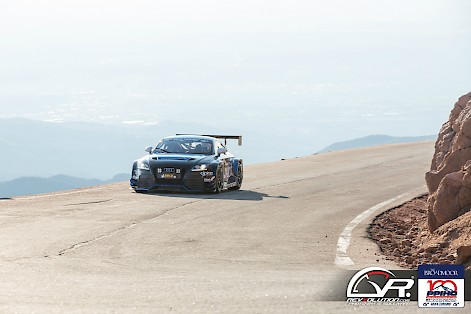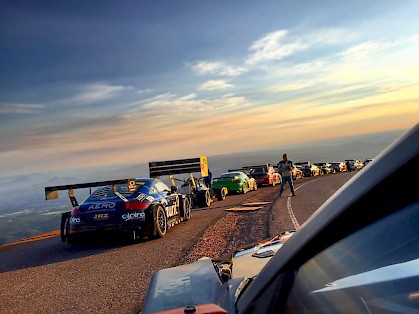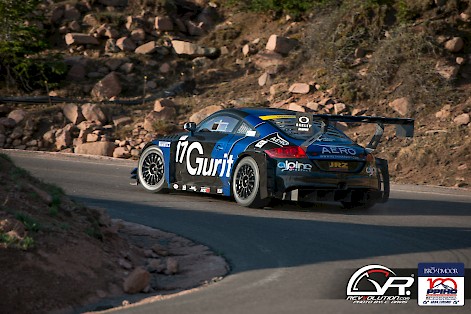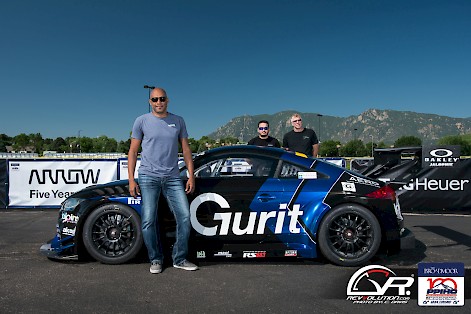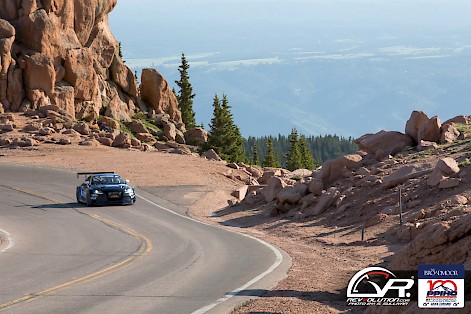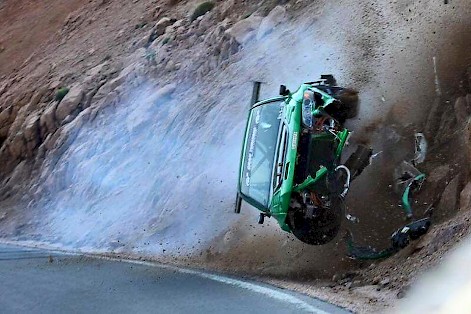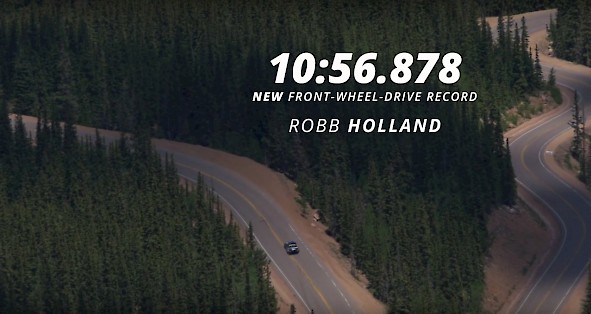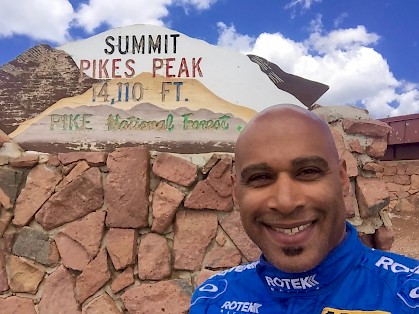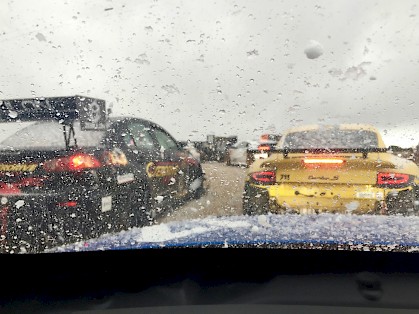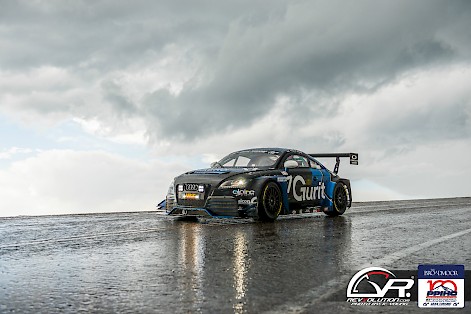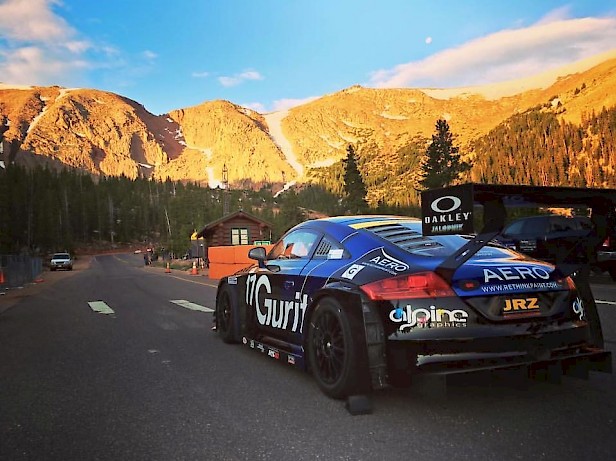
Going Batshit Crazy at Pikes Peak
By Robb Holland
This article originally appears on Blackfag.Jalopnik.com
Two weeks after redefining my standard for batshit crazy at the Isle of Man TT, I found myself sitting at the foot of Pikes Peak, about to blast off up the hill to try to best the record for front-wheel-drive vehicles. And not kill myself in the process.
I’m not sure what was harder—racing up the hill or getting to the starting line.
Photo Credit Ryan Randels
Can’t Race; Town Is On Fire
Quick flashback to 2012. It was the first year that the entire hill was paved. (It’s a mountain, but calling it a hill somehow makes it feel less threatening. Ok not really.) It was what I’d been waiting decades for. I have huge respect for my dirt-driving brethren but I’m not one of them—I can get a car sideways, but usually when that happens its followed by a bunch of swearing and more than a little sphincter clenching.
With asphalt all the way to the top of the hill, I teamed up with the guys from Audi tuners 034 Motorsports to run their 600 horsepower all-wheel drive Audi A4.
Unfortunately the gods had other plans, and they made their intentions very clear by trying to burn down a large part of the forest that surrounds Pikes Peak, along with the fairly large city of Colorado Springs.
Photo credit Sabine Zentgraf via Facebook
The fire was contained, thankfully, but the powers-that-be at the Hill Climb wisely decided to delay the race to let the city focus on reconstruction. Unfortunately for me, they delayed it to the same date that I was going to make my British Touring Car Championship debut. So my team ended up drafting some no-name guy off the street to fill my seat. I think his was name was Randy Pobst or something. (He’s the 2003, 2007, 2008, and 2010 SCCA World Challenge GT champion, if you’re curious.)
Flash forward to 2016. I had spent the intervening years racing over in Europe. Every year the invite to register for the PPIHC would come through in my inbox and every year I would have to decline it. I was always committed to something else. When the invite came for 2016, though, I looked at my calendar and saw that my schedule was open. I couldn’t hit send fast enough.
Can Barely Practice; Test Sessions Are Ultra-Limited
One of the toughest aspects of the Hill Climb is that there are virtually no opportunities to run the course. Road racers like myself get test sessions prior to a race to dial in our speed. They normally last 20 to 30 laps, pushing the boundaries inch by inch, lap after lap until we find our ultimate pace.
That is not the case at Pikes Peak.
During the Pikes Peak International Hill Climb practice days, the mountain is divided into three sections: Lower, Middle, and Upper, while the field is divided into three groups by class. With more than 30 vehicles per group, any individual driver is lucky to get three, maybe four runs during each session.
To make matters worse there is limited parking on the mountain, so each section in testing finishes several hundred yards prior to the start line of the following section. That means that there are several hundred yards and multiple corners that you never get to run in practice at all! On top of that, you never get to hit the start of each section at race speed because you’re starting from a standstill.
Photo credit Robb Holland/Facebook
I had to beg and plead to get admitted to one of the two tire test weekends prior to the event just to get some more seat time.
Photo credit Ryan Randels
Rotek Racing’s top mechanic Ryan Imperial got the TTRS dialed in at a local track a few days before the tire test, and Pirelli sent across the racing slicks I would need. My guys at Alpine Graphics had the car re-painted with their lightweight AERO™ film-based paint solution and stickered up with all of our various sponsors. We were good to go.
Except we weren’t.
Can’t Test; The Car Is Broken
During the shakedown I noticed that the anti-lock brake system and traction control warning lights would not go of, meaning that I had no TC or ABS. Now I understand that the purists among you will say you don’t need all new fangled computers to drive a car. Yeah, I get that. Most of the cars I race don’t have driver aids. But this one does, and it does for a reason.
This particular TTRS has what is known as a metric fuckton of downforce, which is a technical term. If the rear tires don’t heat up evenly—and they never do—then you are guaranteed to lock up a wheel under braking. If that happens and the car starts to yaw, you lose downforce off the rear wing and poof, there you go off the side of the mountain. So not having ABS is a big deal.
Photo credit Ryan Randels
My team mechanics Ryan and Alex managed to trace the issue back to two faulty wheel speed sensors, which was more than a bit of an issue seeing as we only had one spare. A quick call to Audi Customer Racing head honcho Tristan Herbert (he of the quick thinking save at Sebring) revealed that the wheel speed sensors we needed were on back order for the next couple of weeks.
I didn’t have a couple of weeks. I needed to test in a couple of days.
The TTRS shares the same sensor as the R8 GT3 car, so I frantically called Flyings Lizards’ lead race engineer, Thomas Blam. He graciously had his guys remove a sensor from one of his cars and sent it over. But this took so much time that we were unable to get our TTRS up and running in time to make the tire test. So my first time seeing the mountain in four years would be at practice. That was at 5:00 a.m., the Tuesday prior to the race. Not ideal.
Now the sharp-eyed among you may have noticed that I said I would see the course at five in the morning. Unfortunately, that is not a typo. Because Pikes Peak is a National Historic Landmark and normally opens to the public at 7:30 a.m. (moved back to 8:30 during race week), we need to be done practicing by 8:30 and totally off the hill by 9:30. That means practice needs to start at five.
Even worse, because the mountain is divided into three sections for practice, the guys on the upper two sections need to be on the hill no later than 4:00 a.m. That means you’re up and out of bed at 2:00 a.m. for the entire week, unloading the car and setting up your pit area at 3:30 a.m., in the dark, in 35 degree temps, at 10,000 feet. In short, it’s early, dark, cold, and you can’t breathe.
This is fun, right? Right?
Photo credit Ryan Randels
Can Barely Drive; Equipment Issues At Altitude
One of our other carefully-laid road racing plans that didn’t work out so well on Pikes Pike was our tire warmers. The road temp is around 40 degrees in the morning on the course and our Pirellis only really start working at temperatures closer to 200 degrees, which means we need to get our tires up to temperature before we hit the road. For that, we need a generator to power the heating blankets that we use to get the tires up to operating temps before I go out. Our generator normally puts out around 3300 watts, which is more than enough to get the blankets hot. Normally.
What we didn’t take into consideration is that the generator is powered by a naturally-aspirated gas engine. When it suddenly found itself at 10,000 feet, it decided to act exactly like any other naturally-aspirated engine at 10,000 feet and put out 30 percent less power. Dammit.
This lack of power meant that we struggled to get the tires up to no more than 150 degrees, which by the end of our practice run fell to 90. Let me tell you what it’s like driving 90 degree slicks on a 40 degree road, at 5 a.m., in the dark, on the side of a 14,000 foot mountain.
[Insert copious profanity here.]
The biggest issue with cold tires on a cold road is that the driver (me) has absolutely on feeling on how much grip is available. That gives you absolutely no confidence in the car, especially in the corners.
Now let me tell you a bit how the TTRS works. It’s a fairly light car at around 2,400 pounds, but it only has about 370 horsepower, or probably about 20 percent less then that at this altitude. But like I said before, it has a metric fuckton of downforce (sorry for all these technical terms), which allows it to carry huge corning speed.
If you’ve got cold tires and no confidence in the car, however, carrying big cornering speed is the last thing you want to be doing. So the primary goal in practice and qualifying became learning the road, not pushing so hard that I make a mistake and end my chance for breaking the front-drive record, if not end my ability to eat food without having to use straw for the rest of my life.
Photo credit Narvaez Racing/Facebook
So I didn’t push too hard. We ran constantly in the top four or five in class in all of the practice sessions. For qualifying (on the lower section through Glen Cove) on Thursday I intentionally laid back a bit and qualified eighth in class and 28th overall. That put us in the perfect start position for the race on Sunday, as the start order is decided by qualifying and the later you start the warmer the track temperatures usually are, at least to a point.
Video credit Jack Davidson, Multimedia Specialist at iRacing.com
The weather at Pikes Peak is notorious for turning nasty later in the day (more on this later), so the strategy is to get a later start – but not too late. We nailed this with a starting spot that should have had me starting around 11:00-ish, but once again, the hill does not treat rookies kindly.
A delay to getting the motorcycles off in the morning and several delays for the early cars put my start time back to closer to noon. I wasn’t too worried, as the weather seemed to be holding and the road temp was climbing. The delays also gave us more time to keep our Pirellis in their tire blankets, getting them dialed into their temperature operating window.
Except they weren’t. Our overworked-at-high-altitude generator began sounding like an asthmatic hamster on a treadmill shortly before it completely gave up the ghost and called it quits.
Best laid plans and all that.
The Race Gives Back; Competitors Come To Our Aid
Fortunately the PPIHC paddock is a very friendly place. I think it’s a “brothers in arms” type of mentality. We are not racing each other so much as we’re racing the mountain. First, my buddy Tony Brakohiapa’s crew allowed us to plug a pair of our blankets into their generator, which at least allowed us to keep the rear tires warm, which is most important on a front-wheel-drive car. Then Rhys Millen’s crew graciously let us use their pit spot and generator after Rhys took off for his run. It probably helped that I let Rhys use my spare HANS earlier in the week since his was with his Global Rallycross car.
Between all of the help we got from our competitors, combined with the later start time and warm temperatures, I was able to start the run with the best car I had all week.
It All Comes Together; Break The Front-Drive Record
After the whole build up to the weekend the run itself is somewhat anti-climatic. Ten minutes, 56.8 seconds of absolute focus punctuated by brief moments of sheer terror and then a checkered flag and an (unofficial until it can be officially verified) new FWD record at Pikes Peak.
Crossing the line at the top I now understand why almost every competitor gives a fist pump as they cross the line. The sense of accomplishment you feel finishing this race is unlike anything I have experienced in motorsports. It’s definitely not the feeling of conquering the mountain. (I think only guys like Sebastian Loeb or Ari Vatanen can legitimately claim to have conquered it.)
It’s more the feeling you’d get by smacking a hungry lion in the ass and running away. You’re alive, sure, but you know that things easily could have gone the other way and you’d have been lion turds by the end of the day.
Photo credit Robb Holland/Facebook
However crossing the line did not mean my adventures for the day were done. There were still several dozen cars behind me, so I knew I was going to be up at the top of the hill for quite a while longer. The crew at PPIHC kindly serves food to everyone who makes it up to keep us from starving, including the world famous Pikes Peak high-altitude doughnuts.
This year there seemed to be a bunch of issues with the later running cars and one Semi making it all the way to the top. One by one, several of the cars behind me crashed or broke down. The big issue with that, other than the drivers’ safety, of course, is that racers on course behind the incident get red flagged, turned around and forced to head back down the hill to re-start. All of that takes time.
Slicks On Snow; Grip is Highly Overrated
Us early runners were stuck up on the mountain for more than a few hours. Not a huge deal as it gave me a chance to chat with a bunch of the other guys, all super cool and interesting. Except as the hours wore on, the weather started to look a bit, uh, gnarly with a continued chance of gnarly for the remainder of the day.
One minute it’s bright sunshine and the next you can’t see the car in front of you through the fog. Except it’s not fog. Because we are at 14,000 feet what I thought was fog was actually a cloud! I was in a fucking cloud! And we all know what comes in clouds: rain! Which of course turned to hail, which then turned to snow all in a matter of minutes.
Photo credit Robb Holland/Facebook
Once the cloud passed and I could see again, I realized there was almost an inch of snow on the ground and I had to get down the mountain on cold slick tires.
This was the most batshit crazy part of my day. I was sliding sideways at three miles an hour with no control whatsoever, on 14 percent grades, on the edge of a thousand-foot drop off, on iced-over roads, with racing slicks. I wish I had turned my video camera on for the drive down. After almost 45 minutes of sheer terror I finally made it back down to the start line.
Photo credit Ryan Randels
I keep hearing that Pikes Peak is a bucket list item to either race or watch, and after coming here I fully agree. This is one of the greats, equal in every way to the Isle of Man or the Nürburgring as some of the most Batshit Crazy racing in the world.
Can’t wait to do it again next year.
Lastly (and in the spirt of PPIHC camaraderie) Tate Poorman crewman from the Apex Auto Works Team that built and ran the Exocet racecar that finished 26th overall, passed away suddenly just days before the race. He left behind a wife and six kids.
The Apex Auto Works team and Exomotive have donated the hood from their race car, which has been signed by many of the competitors of this year’s PPIHC, to be auctioned off on eBay. All proceeds will go to Tate’s wife and kids. The auction can be found here.
